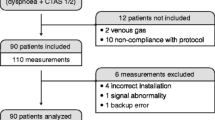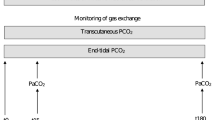Abstract
Objective
For transcutaneous carbon dioxide pressure (tcPCO2) measurement, the probe on the trunk or extremities has been used for many years. Our previous study showed that chest was better than arm for tcPCO2 monitoring. Recently, the ear probe has been developed. The accuracy of tcPCO2 as a surrogate measurement of arterial carbon dioxide pressure (PaCO2) has not been compared between the measurement with probe on the chest and measurement with probe on the earlobe. This study compared the accuracy of tcPCO2 measured on the chest and tcPCO2 measured on earlobe during general anesthesia in adults using linear regression analysis and Bland–Altman plot.
Methods
Ten patients aged 30–70 years scheduled for abdominal surgery under general anesthesia were enrolled. TcPCO2 by TCM4™ (Radiometer, Copenhagen, Denmark, TtcPCO2) with its probe on the chest, tcPCO2 by Sentec™ (Sentec AG, Therwil, Switzerland, StcPCO2) with ear probe, end-tidal carbon dioxide pressure (EtCO2), and PaCO2 were simultaneously measured at four different sets of EtCO2 levels in each patient. In total, 40 measurements were performed. The Scatter plot and Bland–Altman plot were obtained. Correlation coefficient (R2) ≥0.70 and limits of agreement ≤4 mmHg were judged as significant.
Results
TtcPCO2 showed significant positive correlation with PaCO2 (R2 = 0.80) but StcPCO2 did not (R2 = 0.55). TtcPCO2 and PaCO2, and StcPCO2 and PaCO2 had large limits of agreement (−6.56 mmHg, 4.21 mmHg and −11.05 mmHg, 7.64 mmHg, respectively). TtcPCO2 and StcPCO2 had no significant correlation (R2 = 0.63) and large limits of agreement (−8.98 mmHg to 7.91 mmHg).
Conclusion
During general anesthesia in adults, both TtcPCO2 and StcPCO2 were not interchangeable with PaCO2, but only TtcPCO2 had good positive correlation with PaCO2.
Similar content being viewed by others
References
Wimberley PD, Gronlund-Pedersen K, Olsson J, Siggaard-Anderson O. Transcutaneous carbon dioxide and oxygen tension measured at different temperatures in healthy adults. Clin Chem. 1985;31:1611–5.
Mahutte CK, Michiels TM, Hassell KT, Trueblood DM. Evaluation of a single transcutaneous PO2–PCO2 sensor in adult patients. Crit Care Med. 1984;12:1063–6.
Nishiyama T, Nakamura S, Yamashita K. Comparison of the transcutaneous oxygen and carbon dioxide tension in different electrode locations during general anaesthesia. Eur J Anaesthesiol. 2006;23:1049–54.
Heuss LT, Chhajed PN, Schnieper P, Hirt T, Beglinger C. Combined pulse oximetry/cutaneous carbon dioxide tension monitoring during colonoscopies: pilot study with a smart ear clip. Digestion. 2004;70:152–8.
Fanelli G, Baciarello M, Squicciarini G, Mailagutti G, Zasa M, Casati A. Transcutaneous carbon dioxide monitoring in spontaneously breathing, nonintubated patients in the early postoperative period. Minerva Anestesiol. 2008;74:375–80.
Rodriguez P, Lellouche F, Aboab J, Buisson CB, Brochard L. Transcutaneous arterial carbon dioxide pressure monitoring in critically ill adult patients. Intensive Care Med. 2006;32:309–12.
Bolliger D, Steiner LA, Kasper J, Aziz OA, Filipovic M, Seeberger MD. The accuracy of non-invasive carbon dioxide monitoring: a clinical evaluation of two transcutaneous systems. Anaesthesia. 2007;62:394–9.
Bland JM, Altman DG. Statistical methods for assessing agreement between two methods of clinical measurements. Lancet. 1986;8476:307–10.
Nishiyama T, Nakamura S, Yamashita K. Effects of the electrode temperature of a new monitor, TCM4, on the measurement of transcutaneous oxygen and carbon dioxide tension. J Anesth. 2006;20:331–4.
Parker SM, Gibson GJ. Evaluation of a transcutaneous carbon dioxide monitor (“TOSCA”) in adult patients in routine respiratory practice. Resp Med. 2007;101:261–4.
Franklin ML. Transcutaneous measurement of partial pressure of oxygen and carbon dioxide. Respir Care Clin N Am. 1995;1:119–31.
Hazinski TA, Severinghaus JW. Transcutaneous analysis of arterial PCO2. Med Instrum. 1982;16:150–3.
Lacerenza S, De Carolis MP, Fusco FP, la Torre G, Chiaradia G, Romagnoli C. An evaluation of a new combined SpO2/PtcCO2 sensor in very low birth infants. Anesth Analg. 2008;107:125–9.
Kagawa S, Severinghaus JW. Errors in monitoring transcutaneous PCO2 on the ear. Crit Care Med. 2005;33:2414–5.
Bernet V, Doll C, Cannizzaro V, Ersch J, Frey B, Weiss M. Longtime performance and reliability of two different PtcCO2 and SpO2 sensors in neonates. Pediatr Anesth. 2008;18:872–7.
Storre JH, Steurer B, Kabitz HJ, Dreher M, Windisch W. Transcutaneous PCO2 monitoring during initiation of noninvasive ventilation. Chest. 2007;132:1810–6.
Vogt R, Rohling R, Kastner S. Evaluation of a combined transcutaneous carbon dioxide pressure and pulse oximetry sensor in adult sheep and dogs. Am J Vet Res. 2007;68:265–70.
Author information
Authors and Affiliations
Corresponding author
Additional information
Nishiyama T, Kohno Y, Koishi K. Comparison of ear and chest probes in transcutaneous carbon dioxide pressure measurements during general anesthesia in adults
Rights and permissions
About this article
Cite this article
Nishiyama, T., Kohno, Y. & Koishi, K. Comparison of ear and chest probes in transcutaneous carbon dioxide pressure measurements during general anesthesia in adults. J Clin Monit Comput 25, 323–328 (2011). https://doi.org/10.1007/s10877-011-9311-3
Received:
Accepted:
Published:
Issue Date:
DOI: https://doi.org/10.1007/s10877-011-9311-3




